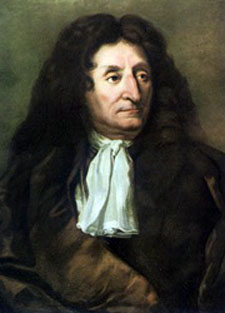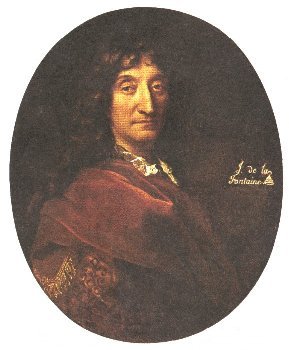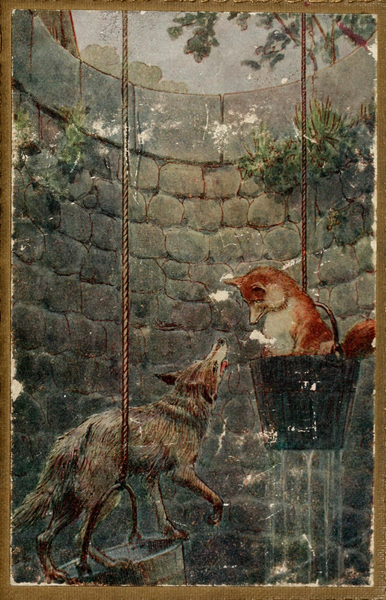<Back to Index>
- Mathematician Henri Paul Cartan, 1904
- Fabulist Jean de La Fontaine, 1621
- Rear Admiral of the Royal Navy Francis Leopold McClintock, 1819
PAGE SPONSOR



Jean de La Fontaine (July 8, 1621, Château-Thierry – April 13, 1695) was the most famous French fabulist and one of the most widely read French poets of the 17th century.
According to Flaubert, he was the only French poet to understand and master the texture of the French language before Hugo. A set of postage stamps celebrating La Fontaine and the Fables was issued by France in 1995. A film of his life was released in France in April 2007 (Jean de La Fontaine - le défi starring Laurent Deutsch). La Fontaine was born at Château-Thierry in Champagne. His father was Charles de La Fontaine, maître des eaux et forêts - a kind of deputy-ranger - of the duchy of Château-Thierry; his mother was Françoise Pidoux. Both sides of his family were of the highest provincial middle class; though they were not noble, his father was fairly wealthy. Jean, the eldest child, was educated at the collège (grammar school) of Reims,
and at the end of his school days he entered the Oratory in May 1641,
and the seminary of Saint-Magloire in October of the same year; but a
very short sojourn proved to him that he had mistaken his vocation. He
then apparently studied law, and is said to have been admitted as avocat (lawyer).
He
was, however, settled in life, or at least might have been so, somewhat
early. In 1647 his father resigned his rangership in his favor, and
arranged a marriage for him with Marie Héricart, a girl of
fourteen, who brought him twenty thousand livres, and expectations. She
seems to have been both beautiful and intelligent, but the two did not
get along well together. There appears to be absolutely no ground for
the vague scandal as to her conduct, which was, for the most part,
raised long afterwards by gossips or personal enemies of La Fontaine.
All that can be positively said against her is that she was a negligent
housewife and an inveterate novel reader; La Fontaine himself was
constantly away from home, was certainly not strict in point of
conjugal fidelity, and was so bad a man of business that his affairs
became involved in hopeless difficulty, and a separation de biens had
to take place in 1658. This was a perfectly amicable transaction for
the benefit of the family; by degrees, however, the pair, still without
any actual quarrel, ceased to live together, and for the greater part
of the last forty years of La Fontaine's life he lived in Paris while
his wife dwelt at Chateau Thierry, which, however, he frequently
visited. One son was born to them in 1653, and was educated and taken
care of wholly by his mother. Even
in the earlier years of his marriage La Fontaine seems to have been
much in Paris, but it was not until about 1656 that he became a regular
visitor to the capital. The duties of his office, which were only
occasional, were compatible with this non-residence. It was not until
he was past thirty that his literary career began. The reading of Malherbe,
it is said, first awoke poetical fancies in him, but for some time he
attempted nothing but trifles in the fashion of the time - epigrams, ballades, rondeaux, etc. His first serious work was a translation or adaptation of the Eunuchus of Terence (1654). At this time the Maecenas of French letters was the Superintendent Fouquet,
to whom La Fontaine was introduced by Jacques Jannart, a connection of
his wife's. Few people who paid their court to Fouquet went away
empty-handed, and La Fontaine soon received a pension of 1000 livres
(1659), on the easy terms of a copy of verses for each quarters
receipt. He also began a medley of prose and poetry, entitled Le Songe de Vaux, on Fouquet's famous country house. It
was about this time that his wife's property had to be separately
secured to her, and he seems by degrees to have had to sell everything
that he owned; but, as he never lacked powerful and generous patrons,
this was of small importance to him. In the same year he wrote a ballad, Les Rieurs du Beau-Richard, and this was followed by many small pieces of occasional poetry addressed to various personages from the king downwards. Fouquet
soon incurred the royal displeasure, but La Fontaine, like most of his
literary proteges, was not unfaithful to him, the well-known elegy Pleurez, Nymphes de Vaux, being by no means the only proof of his devotion. Indeed it is thought not improbable that a journey to Limoges in
1663 in company with Jannart, and of which we have an account written
to his wife, was not wholly spontaneous, as it certainly was not on
Jannart's part. Just at this time his affairs did not look promising. His father and he had assumed the title of esquire,
to which they were not strictly entitled, and, some old edicts on the
subject having been put in force, an informer procured a sentence
against the poet fining him 2000 livres. He found, however, a new
protector in the duke and still more in the Duchess of Bouillon,
his feudal superiors at Chateau Thierry, and nothing more is heard of
the fine. Some of La Fontaine's liveliest verses are addressed to the
duchess, Marie Anne Mancini, the youngest of Mazarin's nieces, and it is even probable that the taste of the duke and duchess for Ariosto had something to do with the writing of his first work of real importance, the first book of the Contes,
which appeared in 1664. He was then forty-three years old, and his
previous printed productions had been comparatively trivial, though
much of his work was handed about in manuscript long before it was
regularly published. It
was about this time that the quartet of the Rue du Vieux Colombier, so
famous in French literary history, was formed. It consisted of La
Fontaine, Racine, Boileau and Molière, the last of whom was almost of the same age as La Fontaine, the other two considerably younger. Chapelain was
also a kind of outsider in the coterie. There are many anecdotes, some
pretty obviously apocryphal, about these meetings. The most
characteristic is perhaps that which asserts that a copy of Chapelain's
unlucky Pucelle always
lay on the table, a certain number of lines of which was the appointed
punishment for offences against the company. The coterie furnished
under feigned names the personages of La Fontaine's version of the Cupid and Psyche story, which, however, with Adonis, was not printed till 1669. Meanwhile
the poet continued to find friends. In 1664 he was regularly
commissioned and sworn in as gentleman to the duchess dowager of
Orléans, and was installed in the Luxembourg. He still retained his rangership, and in 1666 we have something like a reprimand from Colbert suggesting
that he should look into some malpractices at Chateau Thierry. In the
same year appeared the second book of the Contes, and in 1668 the first
six books of the Fables,
with more of both kinds in 1671. In this latter year a curious instance
of the docility with which the poet lent himself to any influence was
afforded by his officiating, at the instance of the Port-Royalists, as editor of a volume of sacred poetry dedicated to the Prince of Conti. A
year afterwards his situation, which had for some time been decidedly
flourishing, showed signs of changing very much for the worse. The
duchess of Orléans died, and he apparently had to give up his
rangership, probably selling it to pay debts. But there was always a
providence for La Fontaine. Madame de la Sablière,
a woman of great beauty, of considerable intellectual power and of high
character, invited him to make his home in her house, where he lived
for some twenty years. He seems to have had no trouble whatever about
his affairs thenceforward; and could devote himself to his two
different lines of poetry, as well as to that of theatrical composition. In 1682 he was, at more than sixty years of age, recognized as one of the first men of letters of France. Madame de Sévigné,
one of the soundest literary critics of the time, and by no means given
to praise mere novelties, had spoken of his second collection of Fables published
in the winter of 1678 as divine; and it is pretty certain that this was
the general opinion. It was not unreasonable, therefore, that he should
present himself to the Académie française, and, though the subjects of his Contes were
scarcely calculated to propitiate that decorous assembly, while his
attachment to Fouquet and to more than one representative of the old Frondeur party
made him suspect to Colbert and the king, most of the members were his
personal friends. He was first proposed in 1682, but was rejected for Marquis de Dangeau.
The next year Colbert died and La Fontaine was again nominated. Boileau
was also a candidate, but the first ballot gave the fabulist sixteen
votes against seven only for the critic. The king, whose assent was
necessary, not merely for election but for a second ballot in case of
the failure of an absolute majority, was ill-pleased, and the election
was left pending. Another vacancy occurred, however, some months later,
and to this Boileau was elected. The king hastened to approve the
choice effusively, adding, Vous pouvez incessamment recevoir La Fontaine, il a promis d'etre sage. His
admission was indirectly the cause of the only serious literary quarrel
of his life. A dispute took place between the Academy and one of its
members, Antoine Furetière,
on the subject of the latter's French dictionary, which was decided to
be a breach of the Academy's corporate privileges. Furetiere, a man of
no small ability, bitterly assailed those whom he considered to be his
enemies, and among them La Fontaine, whose unlucky Contes made
him peculiarly vulnerable, his second collection of these tales having
been the subject of a police condemnation. The death of the author of
the Roman Bourgeois, however, put an end to this quarrel. Shortly afterwards La Fontaine had a share in a still more famous affair, the celebrated Ancient-and-Modern squabble in which Boileau and Charles Perrault were the chiefs, and in which La Fontaine (though he had been specially singled out by Perrault for favorable comparison with Aesop and Phaedrus)
took the Ancient side. About the same time (1685 – 1687) he made the
acquaintance of the last of his many hosts and protectors, Monsieur and
Madame d'Hervart, and fell in love with a certain Madame Ulrich, a lady
of some position but of doubtful character. This acquaintance was
accompanied by a great familiarity with Vendôme, Chaulieu and the
rest of the libertine coterie of the Temple; but, though Madame de la
Sablière had long given herself up almost entirely to good works
and religious exercises, La Fontaine continued an inmate of her house
until her death in 1693. What
followed is told in one of the best known of the many stories bearing
on his childlike nature. Hervart on hearing of the death, had set out
at once to find La Fontaine. He met him in the street in great sorrow,
and begged him to make his home at his house. J'y allais was
La Fontaines answer. He had already undergone the process of conversion
during a severe illness the year before. An energetic young priest, M.
Poucet, had brought him, not indeed to understand, but to acknowledge
the impropriety of the Contes, and it is said that the destruction of a new play of some merit was demanded and submitted to as a proof of repentance. A pleasant story is told of the young duke of Burgundy, Fenelon's
pupil, who was then only eleven years old, sending 50 louis to La
Fontaine as a present of his own motion. But, though La Fontaine
recovered for the time, he was broken by age and infirmity, and his new
hosts had to nurse rather than to entertain him, which they did very
carefully and kindly. He did a little more work, completing his Fables
among other things; but he did not survive Madame de la Sablière
much more than two years, dying on 13 April 1695, at the age of
seventy-three. When the Père Lachaise Cemetery opened in Paris, Lafontaine's remains were moved there. His wife survived him nearly fifteen years. The
curious personal character of La Fontaine, like that of some other men
of letters, has been enshrined in a kind of legend by literary
tradition. At an early age his absence of mind and indifference to
business gave a subject to Gédéon Tallemant des Réaux.
His later contemporaries helped to swell the tale, and the 18th century
finally accepted it, including the anecdotes of his meeting his son,
being told who he was, and remarking, Ah, yes, I thought I had seen him somewhere!,
of his insisting on fighting a duel with a supposed admirer of his
wife, and then imploring him to visit at his house just as before; of
his going into company with his stockings wrong side out, &c.,
with, for a contrast, those of his awkwardness and silence, if not
positive rudeness in company. It ought to be remembered, as a comment on the unfavourable description by Jean de La Bruyère, that La Fontaine was a special friend and ally of Benserade,
La Bruyere's chief literary enemy. But after all deductions much will
remain, especially when it is remembered that one of the chief
authorities for these anecdotes is Louis Racine,
a man who possessed intelligence and moral worth, and who received them
from his father, La Fontaine's attached friend for more than thirty
years. Perhaps the best worth recording of all these stories is one of
the Vieux Colombier quartet, which tells how Molière, while
Racine and Boileau were exercising their wits upon le bonhomme or le bon (by both which titles La Fontaine was familiarly known), remarked to a bystander, Nos beaux esprits ont beau faire, ils n'effaceront pas le bonhomme. They have not.
The
numerous works of La Fontaine fall into three traditional divisions:
the Fables, the Contes and the miscellaneous works. Of these the first
may be said to be known universally, the second to be known to all
lovers of French literature, the third to be with a few exceptions
practically forgotten. The
Fables exhibit the versatility and fecundity of the author's talent
more fully than any of his other work. La Fontaine had many
predecessors in the fable, especially in the beastfable. The poet took inspiration from Aesop, Horace, Boccaccio and Ariosto and Tasso, Machiavelli's comedies and ancient Indian literature, such as the Panchatantra: The first collection of 124 Fables Choisies had appeared March 31, 1668, wisely dedicated to "Monseigneur" Louis, le Grand Dauphin, the six year old son of Louis XIV of France and his Queen consort Maria Theresa of Spain.
In this first issue, comprising what are now called the first six
books, La Fontaine adhered to the path of his predecessors with some
closeness; but in the later collections he allowed himself far more
liberty, and it is in these parts that his genius is most fully
manifested. The
boldness of the politics is as much to be considered as the ingenuity
of the moralizing, as the intimate knowledge of human nature displayed
in the substance of the narratives, or as the artistic mastery shown in
their form. It has sometimes been objected that the view of human
character which La Fontaine expresses is unduly dark, and resembles too
much that of La Rochefoucauld, for whom the poet certainly had a profound admiration. It may only be said that satire (and La Fontaine is eminently a satirist) necessarily concerns itself with the darker rather than with the lighter shades. Perhaps the best criticism ever passed upon La Fontaine's Fables is that of Silvestre de Sacy,
to the effect that they supply delights to three different ages: the
child rejoices in the freshness and vividness of the story, the eager
student of literature in the consummate art with which it is told, the
experienced man of the world in the subtle reflections on character and
life which it conveys. Nor has any one, with the exception of a few
paradoxers like Rousseau and a few sentimentalists like Lamartine,
denied that the moral tone of the whole is as fresh and healthy as its
literary interest is vivid. The book has therefore naturally become a
standard French reader both at home and abroad. It is no small
testimony to its merit that not even this use (or misuse) has
interfered with its popularity. La Fontaine's Fables provided a model for subsequent fabulists, including Poland's Ignacy Krasicki and Russia's Ivan Krylov.